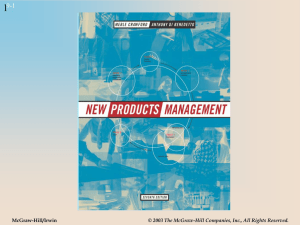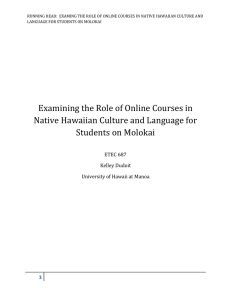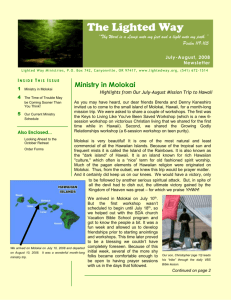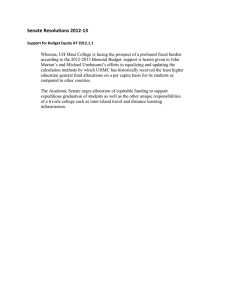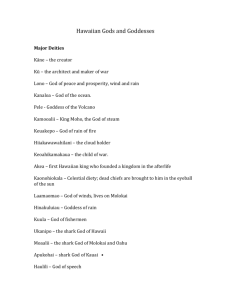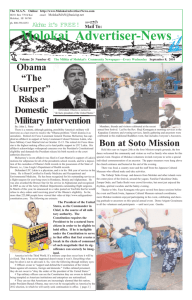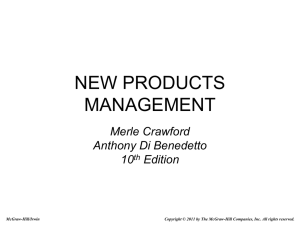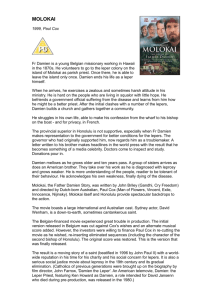Molokai Education Center
advertisement
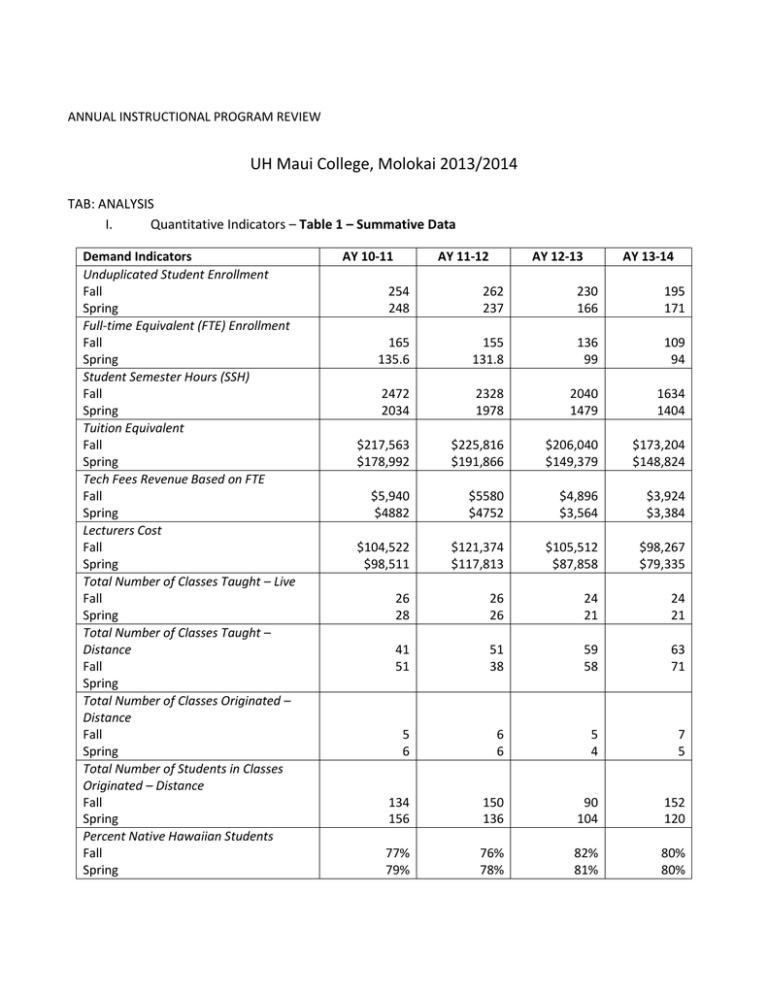
ANNUAL INSTRUCTIONAL PROGRAM REVIEW UH Maui College, Molokai 2013/2014 TAB: ANALYSIS I. Quantitative Indicators – Table 1 – Summative Data Demand Indicators Unduplicated Student Enrollment Fall Spring Full-time Equivalent (FTE) Enrollment Fall Spring Student Semester Hours (SSH) Fall Spring Tuition Equivalent Fall Spring Tech Fees Revenue Based on FTE Fall Spring Lecturers Cost Fall Spring Total Number of Classes Taught – Live Fall Spring Total Number of Classes Taught – Distance Fall Spring Total Number of Classes Originated – Distance Fall Spring Total Number of Students in Classes Originated – Distance Fall Spring Percent Native Hawaiian Students Fall Spring AY 10-11 AY 11-12 AY 12-13 AY 13-14 254 248 262 237 230 166 195 171 165 135.6 155 131.8 136 99 109 94 2472 2034 2328 1978 2040 1479 1634 1404 $217,563 $178,992 $225,816 $191,866 $206,040 $149,379 $173,204 $148,824 $5,940 $4882 $5580 $4752 $4,896 $3,564 $3,924 $3,384 $104,522 $98,511 $121,374 $117,813 $105,512 $87,858 $98,267 $79,335 26 28 26 26 24 21 24 21 41 51 51 38 59 58 63 71 5 6 6 6 5 4 7 5 134 156 150 136 90 104 152 120 77% 79% 76% 78% 82% 81% 80% 80% Efficiency Indicators Average Class Size Fall Spring Fill Rate Fall Spring Faculty Student Ratio Fall Spring AY 10-11 Effectiveness Indicators AY 10-11 Successful Completion (C or Higher) Fall Spring Persistence (Fall to Spring) Unduplicated Associated Degrees Awarded Unduplicated Certificates Awarded AY 11-12 AY 12-13 AY 13-14 20 16 17 14 17 15 15 13 92% 81% 75% 68% 68% 68% 70% 65% 3:254 3:248 3:262 3:237 3:230 3:166 3:195 3:171 AY 11-12 AY 12-13 AY 13-14 78% 67% 75% 74% 60% 62% 63% 76% 81% 20 77% 19 65% 23 71% 16 114 57 38 57 II. Analysis a. Which PLO is being assessed? How is it being assessed (which course(s) is being used to assess the PLO)? The University of Hawaii Maui College (UHMC) outreach sites at Hana, Lahaina, and on Molokai and Lanai have agreed on the following common Program Learning Outcome (PLO): Outreach centers will strive to duplicate the quality educational experience provided at the main UH Maui College campus so the students in our communities will receive the instruction and support they need to be successful in college and beyond. The PLO will be assessed through a set of five program goals listed in Table 2 (on the following page.) Each academic year, UH Maui College, Molokai (UHMC, Molokai) will focus directly on one program goal. For AY 10-11, the focus was on high school graduates applying to UHMC, Molokai; for AY 11-12, the focus was on decreasing the students on academic warning; for AY 12-13, our focus was maintaining the level of upper division enrollments. For AY 13-14, our focus was on increasing the number of students enrolled in distance education courses originating from Molokai. Table 2- Formative Student Learning Outcomes and Program Goal Student Learning Outcomes (SLO) and/or Program Goals Examples of Achievement Indicators within each SLO Mapping SLO to Activity, Course, Project, or other Initiative Assessment Tool and Methods of Utilization Analyzing Results Plan & Implementation Program Goal: Focus: AY 2010-11 To increase the number of high school graduates applying to UHMC directly from high school Continue working with Molokai High School students, parents, teachers and staff through various projects and partnerships. Gear Up proposals will be submitted to continue outreach projects. Tool: Fall applications Number of high school graduates applying to UHMC: Fall 2010: 24 Fall 2011: 33 Fall 2012: 18 Fall 2013: 21 Fall 2014: 18 Target: +3 student increase per semester starting in Fall 2010 (24) to Fall 2011 (27) to Fall 2012 (30). SLO: Increased awareness of program options on Molokai for local high school graduates. Program Goal: Focus: AY 2011-12 To decrease the percentage of students on academic warning SLO: Increased awareness of 1) Academic warning policy and implications, (2) Resources available to keep from falling into academic warning parameters, (3) Procedure for getting out of academic warning. Weekly presence on high school campus will continue. Methods: Continue tracking the number of Molokai graduates applying to UHMC. Advisory class presentations will be conducted. Initiate a Student Success Campaign in AY 11-12 with an early warning system for at risk students and to increase the students overall knowledge of important deadlines to withdraw, etc. Trends show graduating class sizes are becoming smaller which impacts the number of students applying to UHMC. High risk students will be referred to the Counselor for early intervention Tools: Student Needs Assessment Survey & End of Semester Enrollment Reports Improved communication with instructors and students will increase knowledge of important dates and deadlines Methods: Tracking percentage changes in awareness and monitoring end of semester student GPA’s. Freshman Foundation will be implemented Perkins grant will focus on distance education instructional design and CTE student retention and persistence Maintain peer tutoring program and supplement with volunteer tutors. UH online application presents challenges in obtaining thorough applicant information. Awareness of the academic warning policy: AY 10-11: 59% AY 11-12: 63% AY 12-13: 65% Continue awareness efforts and offering support programs to ensure student success. Awareness of consequences resulting from academic warning improved by 3% from Spring 11-Spring 12. AY 10-11: 55% AY 11-12: 58% AY 12-13: 53% Student mentor and tutor programs will be developed to provide additional support. This measure is no longer tracked because the academic warning policy is not being enforced at UHMC. The average retention rate over four years: AY 10-11: 73% AY 11-12: 75% AY 12-13: 61% AY 13-14: 70% Activities specifically targeting the math lab program will be discussed and implemented. Program Goal: Focus: AY 2012-13 To maintain the level of upper division enrollment throughout the UH system SLO: Understanding program options and transfer opportunities and requirements. Program Goal: Focus: AY 2013-14 To increase the number of students enrolled in distance education courses originating from Molokai. SLO: Courses originating from Molokai are offered at a high quality standard. Program Goal: Focus: AY 2014-15 To increase the number of certificates and degrees awarded over a two-year period SLO: Intellectual growth and building personal confidence and workforce capacity. Steady streams of UHMC students with associate degrees matriculate to UHWO, UHH, and UHM Coordinated campus visits to publicize upper division programs Continued dialog with main campus to bring UHMC upper division courses in sequence for Molokai students to earn BAS degrees Marketing efforts directed towards upper division programming The number of DE courses will continue to grow and realize high enrollment numbers each semester. Transfer workshops Inclusion of higher level program information and handouts at all UHMC, Molokai outreach events. Increase distance education programming originated from Molokai on the UHMC schedule of courses. Use various methods of distance education instruction including SkyBridge and Internet. A ladder approach to certificates within each major ensures that students can earn a credential and build upon it towards a degree. Tools: Needs assessment surveys and upper division enrollment reports by institution. Methods: Continue tracking changes in awareness with needs assessment surveys and use enrollment reports to capture enrollment numbers by institution and program. Tools: Enrollment reports and instructor evaluations. Methods: Enrollment reports will be used to track the number of students. Instructor evaluations will measure the quality of instruction. Schedule of classes will include more short-term certificate opportunities. Tools: Counselor database and graduation application spreadsheet. Marketing initiatives focused on earning credentials. Method: Students are tracked in cohorts within the certificate programs. Graduation applications will be used to capture total number of graduates per semester. Growth in academic advising opportunities and avenues. Awareness of bachelor and master degree offerings on Molokai increased Upper Division enrollment by 11% from AY 10-11 to AY 11-12. AY 10-11: 44% AY 11-12: 55% AY 12-13: 66% AY 13-14: 60% Unduplicated Enrollments: Fall 10: 16 Fall 11: 18 Fall 12: 27 Fall 13: 21 Number of classes originated via DE: AY 10-11: 11 AY 11-12: 12 AY 12-13: 9 AY 13-14: 12 Number of students enrolled in DE courses: AY 10-11: 290 AY 11-12: 286 AY 12-13: 207 AY 13-14: 272 Total certificates and degrees awarded per academic year. AY 11-12: 76 AY 12-13: 71 AY 13-14: 73 A number of certificate & degree programs wrapped up to coincide the Commencement 2012. The number of Molokai students enrolled in upper division programming will be maintained at equal to or greater than 10 per semester. There will be increased awareness of upper division programming and transfer options by the end of Spring 13. Instructor evaluations will reveal over 80% of students would recommend the class to another student by Spring 14. Number of students enrolled in DE courses will exceed 500 by AY 13-14. Target: The projection for AY 11-12 was a 7% increase in the number of certificates/degrees awarded on Molokai. (70 total) This goal was surpassed with 71 total certificates and degrees awarded. The Molokai Commencement of 2012 included more student awardees than previous ceremonies. b. Describe the assessment tools or methods used to analyze the outcome. See Table 2 above. c. Describe summative evidence (attach rubric) d. Discuss result of assessment evidence. See Table 1 above. See Table 2 (previous page.) e. What have you discovered about student learning? In AY 13-14, UHMC, Molokai focused on increasing the number of students enrolled in distance education courses originating from Molokai. For the past few semesters, UHMC, Molokai has consistently scheduled 5-7 online or SkyBridge courses taught by Molokai lecturers per semester. This scheduling increases our overall value to UHMC by expanding the course schedule and bringing in statewide students. The tuition revenue directly benefits UHMC. In addition, Molokai lecturers can share their expertise with a larger audience; reflecting positively on the quality of the on-island instructional program. One important achievement, which focused directly on the Program Goal, was the awarding of an $8,324 Achieving the Dream (ATD) Innovations Project Grant for AY 2013-2014. This grant was written to address the shortage of online course offerings in Hawaiian Studies. The award coincided with the approval of the systemwide Associate in Arts degree in Hawaiian Studies. The two-semester grant was used to support the planning of an online HWST 270 – Hawaiian Mythology course. The scheduling and instruction of the course occurred in Spring 2014 and enrolled a total of 28 students. Because the course was met with such great demand, it will continue to be sustainable by generating enough tuition revenue to exceed the cost of the instructor. Furthermore, research will be done to strategically increase online course offerings originating from Molokai in this subject area. Falling short of the projected goal of 500 distance education students by AY 13-14 is a direct result of the lack of faculty positions on Molokai. UHMC, Molokai has been requesting positions in Hawaiian Studies and Math for many years. These faculty positions increase our ability to offer on-island classes and also give us the opportunity to develop expertise in delivering distance education instruction. The growth in demand for online instruction has been steady and online courses continue to experience high enrollment numbers. However, attracting lecturers to develop online classes has been a challenge. The investment of resources to transfer a course to an online model, coupled with the challenge of learning the technology, has been a deterrent for lecturers who would have to do the additional prep work without any type of compensation or contract to ensure the course would be continuously offered. As the primary consumers of distance education, UHMC, Molokai would be the ideal location for faculty positions assigned to developing distance education classes in high demand areas such as Hawaiian Studies and Math. Mentoring of new online instructors and creating rubrics for assessment of the online courses is essential to quality instruction. All UHMC, Molokai online instructors are encouraged to survey student satisfaction, but the current use of eCafe for this purpose is only moderately successful. eCafe results are distributed to the departments and since UHMC, Molokai is not a department, we do not see the student evaluations of our online instructors. More communication and feedback between the campus departments and the UHMC, Molokai Coordinator is needed. f. Provide evidence that results of student learning have been discussed with Program Advisory Board. The UHMC, Molokai Program Advisory Committee meets when specific issues or concerns need to be addressed. During AY 2013-2014, the Committee was concerned with the completion of the Molokai Long Range Development Plan (LRDP). Correspondence on this issue was handled via phone calls, letters, and one-on-one meetings with the members. At every occasion, student learning was discussed and members were provided with important statistics and documents for their perusal and feedback. No specific comments pertaining to the goal of increasing student enrollment in distance education were recorded. The Molokai Program Advisory Committee will undergo renewal and updating. Most members have served for over twenty years with the immediate goal of building out a UH campus on Molokai. In response to the Chancellor’s request, an assessment was made to determine if Committee representation aligned with the economic sectors on Molokai. The assessment, completed in October 2013, found that the three main sectors of Agriculture, Business, and Health were covered with the addition of a new member in the business sector. Some long-serving members have announced that they will step down when the current Coordinator retires in December 2014. The Coordinator is finalizing membership; adding 3 new members, retiring 6, and leaving 3 spaces open for the next Coordinator to determine. g. Discuss the changes made in curriculum or pedagogy to improve student learning and the results of those changes. In the last UHMC, Molokai Program Review, the lack of success in developmental math courses was highlighted. The data was presented to the Molokai staff, all of whom worked together on solutions to address the issue. As a result, communication between staff members and the instructor increased, more tutoring and proctoring hours were offered, a needs assessment survey was administered in the course and fewer course sections were offered so the instructor could have more one-on-one time with students. Table 3-Math Lab Retention Rates for AY 12-13 and AY 13-14 Math Lab Retention 100% 80% 60% 40% Retention Rate 20% 0% Fall 2012 Spring 2013 Fall 2013 Spring 2014 As evidenced in the graph above, student success increased significantly from an all-time low in the Spring 2013 semester. While there is still significant progress to be made, the remediation efforts implemented by the Molokai staff and lecturer were effective. The presence of the Mu’o A’e program along with the tutoring and mentoring services they provide should help to continue this momentum. To address the lack of data to measure the quality of online instruction originating from Molokai, the HWST 270 course delivered through the ATD grant award included a mid and post course evaluation. Results provided meaningful data illustrating student satisfaction and evidence of learning. Student feedback will continue to serve as an essential tool for evaluation as we move forward in developing online courses. Although not a curriculum or pedagogical change, increasing staff to support student learning was another positive change in AY 13-14. UHMC, Molokai is notoriously short-staffed. In September 2013, an Instructional & Student Support position for distance learning was filled. This G-funded position is crucial to the successful operation of the College because along with distance education, the duties and responsibilities also include the academic support functions routinely covered by 3-4 staff on other campuses. The Library, Learning Center, Computing Services, and proctored testing services are handled by this one staff member. The 1.0 FTE position is funded at .25 FTE by the University Center, Maui so the 21 upper division students enrolled in UH degree programs have on-island support. A Perkins grant-funded position to support Career and Technical Education (CTE) students was filled in October 2013. This position contributed greatly to tracking the progress of our CTE students and increasing their persistence and retention rates. The position also added a much needed evening staff presence in the Learning Resource Center, keeping the facility open for student use and servicing their educational needs and concerns. Spring 2014 also saw the addition of a .50 FTE grant-funded Mu’o A’e counseling position. The duties are to assist their program participants in achieving their educational goals. The primary focus is on helping first-time, full-time, Native Hawaiian students who enroll in developmental Math and/or English courses. Through the initiative of staff, student learning was also improved as student assistants were hired with funding from Gear Up and Perkins grants. The tutors/mentors assisted where gaps existed: in the evening when staff is limited and at the Molokai Farm where most agriculture students take their classes. Student persistence and retention rates have increased. The increase in staff support has also aided in improved student success measures. h. List your programs strengths and weaknesses (in relation to the Program Goals and SLO’s). Strengths $2.25 Million from the Legislature for UHMC, Molokai campus development allocated in 2013. Funding must be encumbered by June 30, 2016. Completion of UHMC, Molokai LRDP to guide campus development to 2027. UHMC, Molokai continues to serve a large percentage of Native Hawaiian students. Retention and persistence have both increased since the previous academic year. Tuition revenue continuously exceeds the cost of instruction. The Ke Kukui Mohala program graduated a second cohort of students in partnership with the Educational Opportunity Center (EOC) and Queen Liliuokalani’s Children Center (QLCC.) The program supports Molokai High School students and families with post-secondary educational planning. The program’s success was highlighted at the Hawaii P-20 College, Career and Community Readiness (CCCR) Symposium in November 2013. Outreach efforts were strengthened: 2014 summer outreach series, informational booths at community activities, partnering events with various agencies, calling campaigns and direct mailing. Scholarship Aha and Financial Aid Kickoff continued in AY 13-14 to assist current and prospective students with navigating the financial aid process and discovering scholarship opportunities. The college successfully leveraged external funding and formed partnerships to support outreach and program development opportunities. Organizations that we have worked with in the past year include: Gear Up, Perkins, EOC, Na Pua No’eau, Mu’o A’e, Molokai High School, Hookui, Kuina, Pai Ka Mana, Kahikina O Ka La, Career Link, Native Hawaiian Education Association, and the QLCC. A student activities fee was initiated in Spring 2013 and the Molokai Student Activities Council was formed to develop on-campus activities and services. The Perkins CTE Transition counselor followed up with 41 individuals who had earned college credentials that were not posted to their STAR transcript reports. An $8324 ATD Innovations grant was secured to develop/teach HWST 270 online. Staff development workshops were held on UH Google Suite to increase work productivity. Computer lab room 106 was upgraded in the summer of 2014. 25 workstations were replaced and the software was upgraded. The agriculture program hosted plant sales for Mother’s Day and Memorial Day to generate revenue for classroom supplies. AG 201 and 281 students partnered to start and maintain a garden and use it as a lab area for their courses. Molokai students participated in the system-wide Agree to Degree campaign by pledging to achieve their academic goals. Personnel at UHMC, Molokai joined various campus committees including: distance learning, strategic planning, budget, student activities directors, student success, etc. Partnered with the Kuhao Business Center and Maui Economic Opportunity (MEO) to host the first Molokai Business Conference for local entrepreneurs. Weaknesses The former UHMC leadership has not aggressively championed projects for Molokai. Despite the completion of the Molokai LRDP and legislative funding on the table, development on Molokai has not been highly prioritized on the main campus. Staff turn-over, both at UHMC, Molokai and at UH West Oahu and UH Hilo have resulted in difficulty getting the word out about upper division opportunities and has negatively affected students who are already enrolled in these programs due to a lack of support. Cost of lecturers is rising and each semester we are exceeding our allocated budget as result of a greater student demand for courses in each of the majors offered here. Difficulty pulling data specifically for Molokai and changes in program formulas made it challenging to track retention and persistence. In addition, the UH online application system does not allow for separation of Molokai applicants for data collection purposes. Lack of G-funded staff in an essential area such as Financial Aid must be addressed, especially considering the high percentage of Molokai students receiving financial assistance. Lack of faculty positions hinders our ability to develop curriculum, grow program enrollment, address instructional problems, and communicate with department chairs at the main campus. Inadequate facilities impede our ability to offer natural science courses, non-credit classes, develop more community partnerships, showcase the arts, etc. The Na Pua No’eau position on Molokai has been vacant for 9 months leaving an underutilized office space and has left their constituents without service. Overall student enrollment was the lowest in the 13-14 academic year. This trend is consistent with the enrollment decline across the UH community colleges. Opportunities The acquired land for expansion, the completed Molokai LRDP, the appropriated $2.25M from the legislature, and the change in UHMC leadership provide UHMC with opportunities to develop the infrastructure to support Molokai student learning. The high Native Hawaiian student enrollment on Molokai coincides with the UHCC strategic directions to award performance funding for an increase in earned associate degrees and certificates for Native Hawaiians. The Molokai CTE Transition Coordinator will focus the grant year on growing these opportunities. The County of Maui is assembling a Molokai committee to begin working to update the 2001 Molokai Community Plan. UHMC, Molokai advisory committee members and other stakeholders have applied to take part in the process and advocate for additional acreage to be earmarked for expansion beyond the current 5-acre site. Strong Molokai enrollment and statewide growth in online courses throughout the UH system allows building of the Molokai lecturer base and providing more employment opportunities. Transitioned five UHMC, Molokai Agriculture majors into the ATS Cultural & Natural Resource Management, Malama Aina program. There is continued interest for ATS degree options. Early College High School, Ho’okui and Running Start are partnership programs that encourage youth to start taking college courses while still in high school. The courses to earn a certificate in GIS Ecosystem Management were offered through a creative hybrid instructional model to students on Molokai. Mu’o A’e program helps to address student success issues in developmental Math and English. With the success of the ATD Innovations project, more opportunities will be explored to offer Hawaiian Studies courses online. The UHMC, Molokai website was transitioned to a newer version of Wordpress, therefore allowing for revision and upgrades. Steady enrollments continued in the Molokai agriculture program with student interns and mentors lending support to students/staff. Greenhouse plants are generating revenue to for the program. Student activities funding can sustain projects aimed at student success which were previously funded through grants. Threats/Challenges The organizational structure of UHMC (and the UH system in general) with regards to Education Centers is one which begs for clarification. Without recognition in UH Board of Regents (BOR) policy, the Education Centers are non-entities. They are not stand alone campuses, not University Centers, and not recognized for their role in providing UH classes to their community of learners. An example in AY 13-14 was the confusion over who needed to approve the Molokai LRDP – the BOR, the UH President, the UHCC Vice President, or the UHMC Chancellor. The ambiguity in structure creates hardship in trying to advocate for essential resources and infrastructure development on Molokai. The current UH moratorium on building new facilities has stalled efforts to request release of $2.25M appropriated for the Molokai campus. Pressure to use the funds for renovation rather than design and planning for new construction goes against the Molokai LRDP and will not be met kindly by the community. UHMC is perceived by the UH system to have sufficient infrastructure as a result of the completion of the Science building and 5 other facilities in the recent past. The UHMC, Molokai campus does not benefit from Kahului campus infrastructure improvements; therefore, there is still unmet need. Federal program guidelines for EOC limit the assistance the Molokai counselor can provide leaving gaps in service to island residents. EOC’s budgeting woes in AY 13-14 have resulted in program instability and staff hours routinely being adjusted to the detriment of students. Staff members on Molokai assume multiple roles to satisfy student needs and maintain a learning environment that models Kahului campus. Many of the staff perform job duties that are beyond the scope of their position description, which may result in staff burnout. Lack of facilities/personnel means that Molokai students do not receive a full-service college experience as do other UH students. The deer problem at the Molokai Farm has prohibited the instructor from doing any field production projects. Constructing a fence would be the best solution to address the problem. Enrollments and FTE have declined along with the rest of the UH system. The threat of less legislative support in years to come will make it even more challenging to increase these statistics. III. Action Plan a. Describe planned changes (pedagogy, curriculum) to improve learning. As previously stated, our action plan is to focus on one Program Goal and its Student Learning Outcome (SLO) per academic year. In AY 13-14, UHMC, Molokai focused on increasing the number of students enrolled in distance education courses originating from Molokai. The number of courses offered and the amount of students enrolled has been maintained. In order to achieve increases in enrollments and online course offerings, the establishment of faculty positions on Molokai is essential. Math and Hawaiian Studies positions have been requested year after year, but have not received a high level of support when competing with other campus needs. b. Describe how your assessment supports your current program goals and/or influence future planning. This assessment provides an honest portrayal of the success being achieved on Molokai and areas where improvement can be made. Faculty, staff, instructors and students have been placing a larger emphasis on growing higher education on Molokai. Strategic planning and increased avenues of communication with stakeholders are ensuring that all input is valued and critical to the overall success of the program. Our commitment to planning and assessment needs to be matched with enthusiasm and support from the main campus in order for growth to continue. In our strategic planning efforts, we aligned our program goals with those of the main campus to ensure we are contributing to the overall health of UHMC. In return, it is time that UHMC supports Molokai. Our development plans are minimal, but they will make an enormous difference to Molokai students and all residents for decades to come. IV. Resource Implications a. Provide detailed description, including itemized costs, of additional resources required to implement change. Additional Funding for Planning, Design & Construction – Multi-Purpose Hall, Molokai LRDP The Molokai LRDP completes facilities planning for the UHMC, Molokai campus which began in the early 1990’s. Of the two new facilities that are identified, the Multi-Purpose Hall is of highest priority. Funds that have been committed by the Legislature are not sufficient for construction. Therefore, UH Maui College could support growth on Molokai by placing this item high on their next Capital Improvement Project (CIP) list and request additional funding to move this project forward. The amount of funds to be requested will depend on the final size and scope of the facility and any public/private partnerships or grant funding that can be committed to the effort. 1.0 FTE Molokai Math Faculty Position ($52,008/yr. plus fringe) The lack of teaching faculty positions on Molokai is detrimental to student success. This is especially true in the core subject areas of Math and English, with Math being the most crucial and in need of filling. The UH Maui College Math department redesigned the developmental math classes so that much of the work is done via computers. At the main campus, there are dedicated Math labs with computer workstations and full time lecturers/instructors staffing the room for 10-12 hours per day. The same situation does not exist on Molokai as the one computer classroom must be shared with all other classes resulting in too many students, not enough lab/testing time. In addition, as a DOE teacher, the lecturer has limited availability to the students. Lastly, decisions made regarding the curriculum are not always communicated to outreach in a timely manner. The results are apparent in the dismal retention numbers. A permanent Molokai Math faculty is sorely needed to shore up this core subject area, to teach this and other Math courses, to provide true lab support, advising, and mentoring of students. This position has been identified in the Liberal Arts Program Review and was close to being funded in AY 12-13 but as of AY 13-14, it remains unfunded. Financial Aid Support (.50 FTE) The changes in implementation of the EOC grant on Molokai demand a solution to the lack of Financial Aid staff on Molokai. So that the current EOC staff does not supplant a required College service, at least a half-time position is warranted. This is a carry-over need from the Comprehensive Program Review 2010. Increase Distance Education Support (1.0 APT Instruction and Student Support (PBA- $38,148 yr. plus fringe) UHMC, Molokai receives approximately 60-64 hours and initiates 6 hours of synchronous distance education (DE) programming per week. A 1.0 FTE staff is responsible for both the successful transmission of DE programming as well as providing on-site support for all DE classes via internet and cable. The position also serves as liaison to the Computing Center, Media Center, Learning Resource Center, and Library. By design, the position devotes 20 hours to covering distance education technological responsibilities, leaving 40-44 hours to be managed by student assistants. The use of student assistants at night when no other staff is present is not optimal and has caused problems especially when exams and quizzes are being given. It is evident that due to the increased student demands during the 14-hour operational day, a single employee trying to cover all academic support duties is not sufficient. This situation has been prioritized as critically urgent for the program and staff well-being. We propose re-describing the duties and responsibilities of the current 1.0 APT position and creating a second academic support position especially designed with late afternoon and evening hours. As a result, the 1.0 APT would retain Distance Education, Library and Learning Resource Center functions (including testing) and the second 1.0 APT position would be assigned Distance Education, Media/Technology, and Computing Center functions. Both staff members having distance education responsibilities is important because of the difference in work schedules (one during regular office hours and the other with a late afternoon/evening schedule) and the volume of work to be completed. In addition, the presence of an APT position at night could provide a safer environment for students and lecturers in the absence of security personnel. This is a carryover need from the Comprehensive Program Review 2010. 1.0 FTE Hawaiian Studies Faculty Position ($52,008/yr. plus fringe) A 9-month instructional faculty position in Hawaiian Language/Hawaiian Studies was first identified as needed on Molokai in 1992 and last requested in the Comprehensive Program Review 2010. Currently, classes are taught by qualified lecturers; however, with the AA in Hawaiian Studies degree, the demand for these courses has increased beyond what lecturers can cover. Given the large percentage of Native Hawaiian students residing on Molokai, the new degree options, and the fact that lecturer funds could be re-assigned to other high need areas, this position is again being requested. TAB: DESCRIPTION Mission and Vision for UH Maui College, Molokai Mission We are the University of Hawaii presence on Molokai providing higher education and serving our island. We empower students to achieve their aspirations and contribute meaningfully to their families and community. University of Hawaii Maui College, Molokai offers a world of knowledge here at home. Vision University of Hawaii Maui College, Molokai students thrive in an environment where each individual is encouraged to be the architect of their own future and is provided with the necessary support to help them achieve success. The institution plays an integral part in grooming island residents to be community managers and leaders. Quality instruction and sufficient facilities and resources provide an educational experience in a rural, low-income area that encourages the attainment of certificates and degrees for a student population of predominately Native Hawaiian learners. University of Hawaii Maui College, Molokai focuses on addressing comprehensive island-wide educational needs. Serving as a liaison for upper-division programming encourages students to continue their education beyond associate degree levels. Outreach services provide opportunities for students K-12 to develop their aspirations and achieve their goals through higher education. TAB: SLOs a. List program learning outcomes-see Table 2 for a list of Program Goals and SLO’s b. Program map (course alignment grid). N/A c. Assessment plan (grid showing plan for assessment focusing on different student learning outcome(s) each year, rolling up the annual assessments during the five –year comprehensive review) Table 4-Assessment Plan Comprehensive Program Review Team Recommendations (2010) Progress (2013-14) Actively pursue future development of the campus as outlined in the Master Plan need for more office space and classrooms (e.g. wet lab for sciences). -Approved Long Range Development Plan (LRDP); presented to the BOR in November 2014 -Secured $2.25M from the State of Hawaii Legislature; request for release of the funds is pending -Meeting with UH IRO to discuss possibility of Molokai specific data collection and to refine current methods of data collection and reporting. -Tracking different types of data and developing a plan for more frequent internal data reports. Capture Molokai Campus data distinct from UHMC to more accurately reflect the activity and productivity of Molokai so that further rationale and justification can be supported by this data for facilities development and personnel/budget requests (e.g., completion rates; need for financial aid professional). Develop less reliance on grant funding for personnel and programs to increase consistency and continuity. Continue excellent innovative curriculum development activities to address the need for continuing professional development in health, education, and construction and help supply homegrown workforce for nursing, teaching, and green technology jobs. Develop distance learning activities further to offer more and varied classes – originate programs from Molokai and utilize the resources you have on island (a number of retired residents with Ph.Ds.’ who want to teach). Support students in Running Start programs (currently grant funded) to increase the number of Native Hawaiian high school students enrolled in college classes. This bodes well -Hired 1.0 Instructional and Academic Support Specialist using Perkins funds and continue to track data to support institutionalization of the position. -Continue tracking financial aid demand and limitations of EOC grant in AY 2013-14 to advocate additional positions for Molokai to meet student needs. -Graduated first class of 14 Therapeutic Activity Aide’s in Spring 2011. Second cohort is being planned. -Solar installation certification course provided 15 students the training in the sustainable living energy resources field. 4 students successfully passed a national exam. -Launched the ATS in Cultural & Natural Resource Management cohort in Fall 2012 with five majors. -Successfully secured free round-trip airfare for 9 NURS 100 students in Spring 2014 so they could complete required labs on Maui. -Number of classes originated via Distance Education: AY 09-10: 10 AY 10-11: 11 AY 11-12: 12 AY 12-13: 9 AY 13-14: 12 -Received grant award to develop a HWST 270 course to be offered online to UH students statewide in Spring 2014. -Continued partnership with Ho’okui program, which uses Running Start as a catalyst for preparing Native Hawaiian youth for college. for future college/university enrollment and supports the community. -Awarded Gear UP grant for AY 13-14 to continue college awareness services to Molokai High School students. -Began new partnership with Molokai High School to develop Early College High School (ECHS) in Fall 2014 Resume needs assessment activities. -Needs assessments are administered at the end of each Spring semester. Most recent assessment took place in Spring 2014. -An organization chart was not completed in AY 13-14. With so few G-funded staff, it did not seem necessary. Essential college functions are filled with positions acquired by external funds. Strategy for AY 13-14 was to continue advocating for G-funded positions although no progress was made. -Offered Cooperative Education classes in Spring 2013 as an initiative to bridge workforce and education. -Developed relationships with partnering agencies who have agreed to support UHMC, Molokai interns interested in careers in agriculture and conservation. -Increased partnership with County of Maui Kuhao Business Center to enhance and showcase current business ventures to stimulate personal and community economy. Develop an assessment/evaluation process that is reflective of the broad range of duties and responsibilities carried out by the Molokai Campus faculty and staff. Continue to pursue academic-industry partnerships to strengthen the pathway from higher education to employment for your graduates. Summary In AY 13-14, UHMC, Molokai focused on the goal of increasing students and courses in distance education. Both indicators were successfully met and there continues to be room for growth in this area. Because distance education is a vital method of instruction for our students to meet their academic goals, we will continue to participate in campus discussions on how we can strengthen distance education instructional support and student retention. The growth experienced by the Molokai program since the permanent facility was established in 1999 has been tremendous. By establishing an educational haven on Molokai, residents have flocked to improve their lives through higher education. Participation from those in the local workforce coupled with the surge in high school and upper division students has brought us to a point where our resources are maximized and in many cases over extended. Some of the personnel roles established are no longer sufficient, the facilities and grounds are utilized to their fullest potential, and academic program limitations create difficulty in meeting expanding community needs. The current economic situation of the State of Hawaii and UH limits the large-scale expansion of facilities and programs. Understanding these circumstances, the Molokai program has focused on setting practical, minimal requests for additional resources. However, the need for basic infrastructure and services like faculty positions, instructional/student support, and financial aid staffing cannot be ignored. Retention, persistence, and graduation rates may continue to be negatively impacted as a result of the lack of teaching faculty and staff members with responsibilities to assist students in understanding their course content, their financial obligations, etc. Current operational efficiency and program demand merit personnel and physical resource expansion on Molokai, especially in areas that are critical to student success and which are routinely provided on other campuses throughout the UH system.
